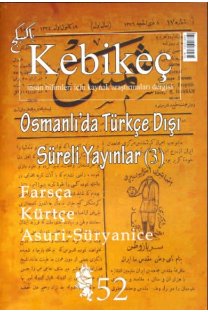Türkiye’nin Fırtına Afeti Etkilenebilirliøi ve Risk Çözümlemesi
Storm Disaster Vulnerability and Risk Analysis of Turkey
___
- Benson C., Twigg J., ve Rossetto T., Tools for Mainstreaming Disaster Risk Reduction: Guidance Notes for Development Organisations. Geneva: The ProVention Consortium, 2007.
- Cannon T., “Vulnerability Analysis and the Explanation of ‘Natural’ Disasters”. Disasters, Development and the Environment içinde, ed. Varley, A. Londra: Belhaven Press, 1994: 13- 30.
- Dao H., ve Peduzzi P., Global Risk and Vulnerability Index Trends per Year (GRAVITY). Phase IV: Annex to WVR and Multi Risk Integration. A technical report for: United Nations Development Programme, Bureau of Crisis Prevention & Recovery (UNDP/BCPR). United Nations Envi-ronment Programme and Global Resource Information Database. Geneva: UNEP/DEWA/GRID, 2003.
- Deniz A., Özdemir E. T., Sezen İ., Coşkun M. “Investigations of storms in the region of Marmara in Turkey”. Theoretical and Applied Climatology 112 (2013): 61-71.
- Donat M. G., Leckebusch G. C., Pinto J. G., Ulbrich U., “Examination of wind storms over Central Europe with respect to circulation weather types and NAO phases”, International Journal Of Climatology 30, (2010): 1289–1300.
- Flanagan B. E., Gregory E. W., Hallisey E. J., Heitgerd J. L., ve Lewis B., “A social vulnerability index for disaster management”. Journal of Homeland Security and Emergency Management 8:1 (2011), Article 3.
- IPA, “Regional Cooperation in South Eastern Europe for Meteorological, Hydrological and Climate Data Management and Exchange to Support Disaster Risk Reduction”. IPA/2009/199-922.
- Koç T., Türkeş M., ve Çalışkan V., “Ocak 2004 Çanakkale kar fırtınasının oluşum ve etkilerinin coğrafi analizi”. Ege Coørafi Bilgi Sistemleri Sempozyumu 27-29 Nisan 2005, Bildiriler Kitabı içinde, ed. M. Kirami Ölgen, İzmir, 2005a: 451-462.
- Koç T., Türkeş M., Çalışkan V., Sarış F., İrdem C., Çavuş C., ve Sağlam A., “Çanakkale kar fırtınası afetinin sosyal ve ekonomik etkilerinin değerlendirilmesi”. Sivil Savunma 181, (2005b): 5-10.
- McDonald J., ve Mehta K. C., A Recommendation for an Enhanced Fujita Scale (EF-Scale), Revision 2. Texas Tech University, Wind Science and Engineering Research Center, 2006.
- Morrow B. H., “Identifying and Mapping Community Vulnerability”. Disasters 23: 1 (1999): 1-18.
- Ngo E. B., “When Disasters and Age Collide: Reviewing Vulnerability of the Elderly”. Natural Hazards Review 2 (2001): 80-89.
- Peduzzi P., Dao H., Herold C., Mouton F., “Global Risk And Vulnerability Index Trends per Year (GRAVITY) Phase III: Drought analysis (Technical report for: United Nations Development Programme Bureau of Crisis Prevention & Recovery [UNDP/BCPR]”, Geneva: 2003. Erişim tarihi 9 Kasım: https://www-fourier.ujfgrenoble.fr/~mouton/Publis_HDR_applis/ew_gravity3.pdf
- Sahin S., ve Türkeş M., “Contemporary surface wind climatology of Turkey”, Theoretical and Applied Climatology 113: 1-2 (2013): 337-349.
- SANHO, South African Tide Tables. Tokai: Naval Hydrographer, South African Navy Publishing Unit, 2009. ISBN 97809584817-4-8.
- Türkeş M., “Influence of geopotential heights, cyclone frequency and Southern Oscillation on rainfall variations in Turkey”. International Journal of Climatology 18 (1998a): 649-680.
- Türkeş M., A Preliminary Assessment of the Western Black Sea Floods in May 1998, Turkey. Unpublished Study, Ankara: State Meteorological Service, 1998b.
- Türkeş M., “Hava, iklim, şiddetli hava olayları ve küresel ısınma”. Devlet Meteoroloji İşleri Genel Müdürlüøü 2000 Yılı Seminerleri içinde, Teknik Sunumlar, Seminerler Dizisi 1, 2001: 187- 205.
- Türkeş M., “2004 Kışı ve ‘İnsan Kaynaklı’ Meteorolojik Afetler Üzerine Bir Değerlendirme”, 2023 42 (2004): 76-79.
- Türkeş M., Klimatoloji ve Meteoroloji. İstanbul: Kriter Yayınevi, 2010.
- Türkeş, M. ve Çeşmeci, H., “Bursa’da lodos fırtınasının oluşumu ve afet boyutunda etkileri”. IV. Atmosfer Bilimleri Sempozyumu Bildiri Kitabı, İstanbul: İstanbul Teknik Üniversitesi, 2008: 563-573.
- Türkeş M. ve Deniz Z. A., “Klimatolojik/meteorolojik ve hidrolojik afetler ve sigortacılık sektörü”, Uluslararası İnsan Bilimleri Dergisi 7 (2010): 996-1020.
- Ulbrich U., Fink A., Klawa M., Pinto J. G., “Three extreme storms over Europe in December 1999”, Weather 56 (2001): 70-80.
- UNDP/BCPR, Reducing Disaster Risk: A Challenge for Development. New York: John S. Swift Co., 2004.
- UNDRO, Natural Disasters and Vulnerability Analysis: Report of Expert Group Meeting (9-12 July 1979), Geneva. Erişim tarihi: 9 Kasım 2018. https://archive.org/details/naturaldisasters00offi
- Wernli H., Dirren S., Liniger M. A., Zillig M. “Dynamical aspects of the life cycle of the winter storm ‘Lothar’ (24–26 December 1999)”, Quarterly Journal of the Royal Meteorological Society 128: 580 (2002): 405–429.
- WMO, Strengthening Multi-Hazard Early Warning Systems and Risk Assessment in the Western Balkans and Turkey: Assessment of Capacities, Gaps and Needs (Regional Programme on Disaster Risk Reduction in South East Europe Activity 2, Phase I Report), Geneva, 2012. Erişim tarihi 9 Kasım 2018:
- http://www.wmo.int/pages/prog/drr/projects/SEE/documents/SEEPhase%20I%20- %20FinalReport.pdf
- ISSN: 1300-2864
- Yayın Aralığı: 2
- Başlangıç: 1995
- Yayıncı: Mehtap Yüksel
Mustafa Suphi’nin Yaşamına Dair Bazı Notlar
Kürt Muhalefetinin Temsili: Yerelden Merkeze
Frantz Fanon’la Konuşmayı Sürdürmek: Kimlik, Tanınma ve Özdeşleşme
Necâset, “Gâvur” Kafatasları ve 19. Yüzyıl Ortasında Doğu Anadolu’da bir Yağmur Ritüeli
“Unutma” ile “Hatırlama” Arasında Türkiye’nin Ermeni Meselesi (1923-1985)
Hayvanın Felaketi, Manzaradan Lekelere: Hayırsızada (Serge Avedikian, 2010)
Yayıncılık Dünyasının Feminizasyonu Süreci: Kadın Çevirmenler Üzerine Bir İnceleme
Yonca Güneş YÜCEL, Gözde ORHAN
Türkiye’nin Fırtına Afeti Etkilenebilirliøi ve Risk Çözümlemesi
